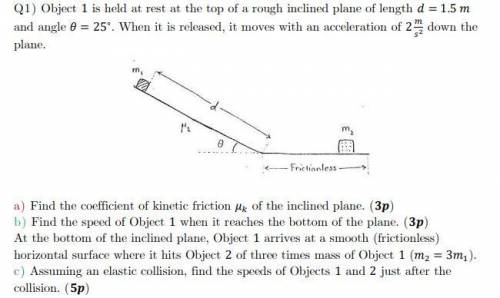
Physics, 21.06.2020 20:57 liyahlanderson2232
Object 1 is held at rest at the top of a rough inclined plane of length = 1.5 and angle = 25∘ . When it is released, it moves with an acceleration of 2m/s^2 down the plane. a) Find the coefficient of kinetic friction of the inclined plane. b) Find the speed of Object 1 when it reaches the bottom of the plane. At the bottom of the inclined plane, Object 1 arrives at a smooth (frictionless) horizontal surface where it hits Object 2 of three times mass of Object 1 (2 = 31). c) Assuming an elastic collision, find the speeds of Objects 1 and 2 just after the collision.


Answers: 1


Other questions on the subject: Physics


Physics, 22.06.2019 15:20, alissalhenry
Arigid tank is divided into two equal parts by a partition. one part of the tank contains 3 kg of compressed liquid water at 400 kpa and 60°c while the other part is evacuated. the partition is now removed, and the water expands to fill the entire tank. determine the entropy change of water during this process, if the final pressure in the tank is 40 kpa. use steam tables.
Answers: 3

Physics, 22.06.2019 17:00, jenn8055
In the future, people will only enjoy one sport: electrodisc. in this sport, you gain points when you cause metallic discs hovering on a field to exchange charge. you are an electrodisc player playing the popular four disc variant. the disks have charges of qa = −8.0 µc, qb = −2.0 µc, qc = +5.0 µc, and qd = +12.0 µc. (1) you bring two disks together and then separate them. you measure the resulting charge of these two disks and find that it is +5.0 µc per disk. which two disks did you bring together? (a) a and b (b) a and c (c)a and d (d)b and c(e) b and d (f) c and d. (2) you bring three disks together and then separate them. you measure the resulting charge of these three disks and find that it is +3.0 µc per disk. which three disks did you bring together? a, b, and c (a) a, b, and d (c) a, c, and d (d) b, c, and d. (3) given the resulting charge of each disk measured in (b) is +3.0 µc, how many electrons would you need to add to a disk of this charge to electrically neutralize it? electrons
Answers: 3

Physics, 22.06.2019 17:00, StupidFatChipmunk
What equation is used to calculate the weight of an object on a plant ?
Answers: 1
You know the right answer?
Object 1 is held at rest at the top of a rough inclined plane of length = 1.5 and angle = 25∘ . When...
Questions in other subjects:



Physics, 29.08.2019 19:50


Physics, 29.08.2019 19:50

Health, 29.08.2019 19:50

Physics, 29.08.2019 19:50

Mathematics, 29.08.2019 19:50




